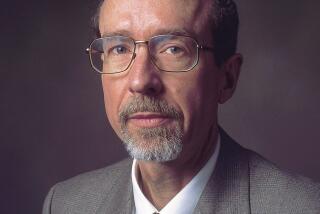Why Moscow Didn’t Fit Beijing Pattern : Democracy: Soviet events eerily paralleled those of Tian An Men Square in 1989. But key differences helped cause opposite outcomes.
- Share via
WASHINGTON — Why did the hard-liners in the Soviet Union fail to roll back the movement towards democracy while their counterparts in China succeeded two years ago?
In some respects, the events that unfolded in Moscow this week were strikingly similar to those at Beijing’s Tian An Men Square in the spring of 1989. Tanks rolled into the capital, where they were surrounded and blocked by what Communist Party leaders have traditionally called the masses.
“I was struck by the visual similarities, by the armored personnel carriers trying to move forward against angry citizens,” said Harry Harding, a China specialist at the Brookings Institution.
In both the Soviet Union this week and in China two years ago, the general secretary of the Communist Party was put under house arrest. In both countries, a senior leader who had only recently met with President Bush was said to have been suddenly incapacitated by an unspecified illness. Both countries were in the midst of economic turmoil: China in 1989 faced runaway inflation, while the Soviet Union faces shortages and virtual economic collapse.
And yet, despite the parallels, those who have followed both crises say there were crucial differences between the upheavals in China in 1989 and those in Moscow--differences that helped swing the outcomes in different ways.
Experts point to at least four critical factors:
- The personalities of political leaders made a big difference. The Soviet hard-liners had no one with the status and seniority of Deng Xiaoping who could unify the army, order the use of violence and repression and make the order stick. Conversely, Chinese reformers had no leader as dynamic as Russian Federation President Boris N. Yeltsin.
- In the years before the crisis, the Soviet Union had already developed political institutions and legal and constitutional processes, including a democratically elected leader. In China, the reformers led by Communist Party Secretary Zhao Ziyang had no comparable claim to legitimacy.
“Since 1985, the Soviet people had enjoyed a lot of political freedom,” said Liu Binyan, China’s foremost dissident journalist, who now lives in Princeton, N.J. Soviet President Mikhail S. Gorbachev and Yeltsin “were elected according to constitutional procedures,” he noted.
- In the case of the Soviet coup, the United States and other Western governments threw their weight quickly, forcefully and unambiguously behind Yeltsin and democratic forces, avoiding the sort of hands-off attitude they displayed in the midst of the Chinese power struggle two years ago.
- There was simply the influence of timing: the Chinese crisis came first and officials in the Soviet Union and overseas were affected by the knowledge of how much blood was shed in Beijing and at what cost.
“Everybody learned things from Tian An Men, including the Soviet reformers, the Europeans and us,” said one senior U.S. official who followed the events in China in 1989 closely. “We learned about the efficacy of the kind of public statements that were made (by the United States) this time.”
Thomas Robinson, a specialist on the Chinese military at the American Enterprise Institute, observed: “The example of Tian An Men weighed heavily in Moscow. I don’t think anyone in Moscow wanted to see a thousand people dead.”
(The number of people who died in Beijing during the army’s assault of June 3-4, 1989, is still unknown, but estimates range from several hundred to well over a thousand).
These factors helped to reinforce one another. For example, Yeltsin’s personal charisma was buttressed by the importance of his legitimacy as the elected president of the Russian Federation. And Gorbachev’s and Yeltsin’s status as constitutionally appointed leaders made it easier for them to win foreign support.
The sequence of events leading to the dramatic showdown between people and tanks also was considerably different.
The triggering event in China was a series of student demonstrations, which provoked a split in the Communist Party leadership over whether to impose martial law.
In the Soviet Union, the crisis was touched off by party hard-liners as part of a coup.
“In China, the hard-liners were the status quo, whereas this time (in the Soviet Union) the hard-liners were the forces seeking to overturn the status quo, “ observed Perry Link, a Chinese literature professor at Princeton University.
Several experts said they believe that personalities were a key factor in Moscow this week and in China two years ago.
“To me, the basic difference was that the Soviet Union did not have a Deng Xiaoping, a senior leader with the personal stature willing to intervene to turn the clock back,” asserted Harding, of the Brookings Institution.
Deng, now 87, had been a top leader of the Chinese Communist Party and the People’s Liberation Army since the days of the Chinese revolution. Neither Soviet Defense Minister Dmitri T. Yazov, now under arrest, nor any other Soviet leader could match those credentials.
The two countries have different political traditions, too. Over the past five years, the Soviet Union moved further than China toward Western-style constitutional government.
At the time of crisis, Soviet officials cared more about foreign governments’ opinions than did Chinese leaders. And Western political leaders found it easier to identify with and support democratic forces in the Soviet Union.
More to Read
Sign up for Essential California
The most important California stories and recommendations in your inbox every morning.
You may occasionally receive promotional content from the Los Angeles Times.













